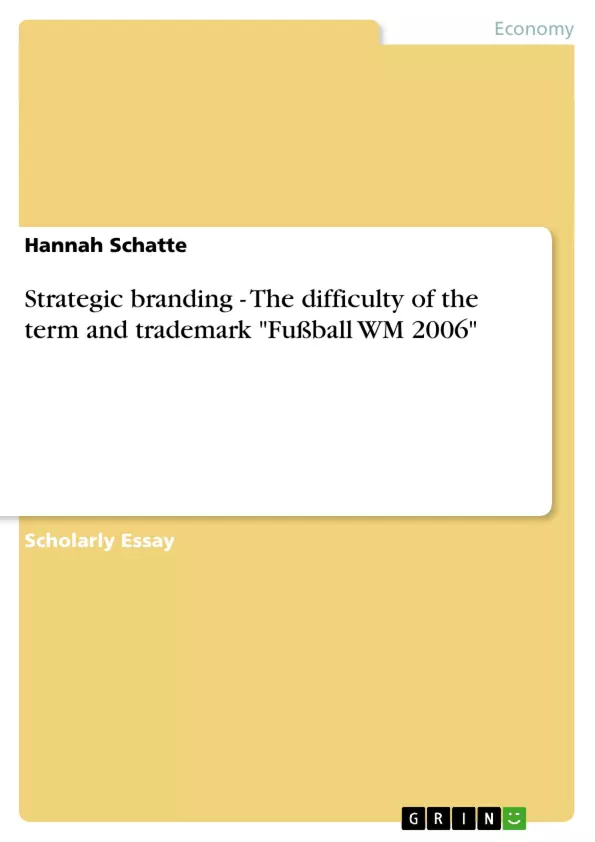The Football World Cup ushers a gigantic marketing machinery where particularly industries such as tourism, catering, culture and media are hoping to gain massive revenues.
Yet the commercialisation of this event does not only bring marketing managers, but also lawyers on board, because the major part of the earnings of those events are not formed by the ticket sales, but by the sponsorship money.
Since the 1980s, sport-sponsoring has increased constantly, due to the fact that companies are hoping to gain an considerable increase in publicity and corporate image benefits.
Given the huge expenses, it is not surprising that not only the organisator of the Football World Cup, namely the FIFA , but also the sponsors are longing for maximized exclusiveness of their trademarkrights.
Along with this exclusiveness comes the concern about competition law matters, which are also adressed under the behaviour of Strategic Branding.
This paper will deal with the problem of Strategic Branding and Ambush-Maketing in cases of eventmarks, using the example of the trademark “Fussball WM 2006” to illustrate the general problems arising from the application of eventmarks.
Inhaltsverzeichnis (Table of Contents)
- Introduction
- Course of investigation
- The importance of branding
- The event-trademark
- The distinctive character
- The Olympic Games
- Strategic Branding
- Ambush-Marketing
- The World-Cup-Saga
- Worldcup 1994
- Worldcup 2006
- Decision of the Higher Regional Court of Hamburg
- Decision of the Federal Patent Court
- The decision of the Federal Court of Justice
- The european effect: decision of the Office for Harmonization in the Internal Market (OHIM)
- The Community trademark
- Decision of the OHIM
- Conclusion
Zielsetzung und Themenschwerpunkte (Objectives and Key Themes)
This paper examines the legal and commercial aspects of Strategic Branding in the context of event marks, using the "Fussball WM 2006" trademark as a case study. The paper aims to explore the challenges arising from the application of event marks, particularly concerning trademark law and its potential conflict with competition law. The key themes covered in this paper include:- The importance of branding in maximizing event-related profits
- The legal and commercial implications of event-trademarks
- The role of Strategic Branding in trademark and competition law
- The legal disputes surrounding the "Fussball WM 2006" trademark
- The impact of event marks on the European Union's trademark laws
Zusammenfassung der Kapitel (Chapter Summaries)
- Introduction: This chapter provides a brief introduction to the topic of Strategic Branding and its relevance in the context of major events, such as the Football World Cup. The chapter emphasizes the commercialization of such events and the importance of trademark rights for both event organizers and sponsors.
- Course of investigation: This chapter outlines the research methodology and the scope of the paper, highlighting the legal and economic aspects of Strategic Branding in the context of event marks.
- The importance of branding: This chapter discusses the significance of branding in event marketing, exploring the strategies used by organizations to enhance their brand image and maximize profits.
- The event-trademark: This chapter delves into the legal definition of event trademarks and analyzes the distinctive character of such trademarks. It also provides examples of event marks, such as those used for the Olympic Games.
- Strategic Branding: This chapter examines the concept of Strategic Branding and its implications for event marketing. It explores the strategies employed by companies to maximize their brand equity and protect their trademark rights.
- Ambush-Marketing: This chapter discusses the practice of ambush marketing, which involves companies attempting to associate their brands with an event without having official sponsorship rights. It explores the legal and ethical dimensions of this practice.
- The World-Cup-Saga: This chapter examines the legal battles that have surrounded the trademark "Fussball WM 2006," focusing on various court decisions and their impact on the broader legal landscape of event marks. It highlights the cases related to the World Cup in 1994 and 2006.
- The european effect: decision of the Office for Harmonization in the Internal Market (OHIM): This chapter explores the European Union's approach to event marks, focusing on the role of the Office for Harmonization in the Internal Market (OHIM) in defining and regulating Community trademarks.
Schlüsselwörter (Keywords)
This paper focuses on the intersection of Strategic Branding, event marks, trademark law, and competition law. Key terms include: Strategic Branding, event marks, trademark rights, competition law, ambush marketing, "Fussball WM 2006", FIFA, OHIM, and Community trademark. The paper utilizes the "Fussball WM 2006" trademark as a case study to analyze the legal and commercial complexities surrounding event marks, particularly in the context of international sporting events.- Quote paper
- Hannah Schatte (Author), 2009, Strategic branding - The difficulty of the term and trademark "Fußball WM 2006", Munich, GRIN Verlag, https://www.grin.com/document/132387



